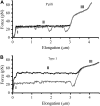The biomechanical properties of E. coli pili for urinary tract attachment reflect the host environment
- PMID: 17675342
- PMCID: PMC2025661
- DOI: 10.1529/biophysj.107.110643
The biomechanical properties of E. coli pili for urinary tract attachment reflect the host environment
Abstract
Uropathogenic Escherichia coli express pili that mediate binding to host tissue cells. We demonstrate with in situ force measuring optical tweezers that the ability of P and type 1 pili to elongate by unfolding under exposure to stress is a shared property with some differences. The unfolding force of the quaternary structures under equilibrium conditions is similar, 28 +/- 2 and 30 +/- 2 pN for P pili and type 1 pili, respectively. However, type 1 pili are found to be more rigid than P pili through their stronger layer-to-layer bonds. It was found that type 1 pili enter a dynamic regime at elongation speeds of 6 nm/s, compared to 400 nm/s for P pili; i.e., it responds faster to an external force. This possibly helps type 1 to withstand the irregular urine flow in the urethra as compared to the more constant urine flow in the upper urinary tract. Also, it was found that type 1 pili refold during retraction at two different levels that possibly could be related to several possible configurations. Our findings highlight functions that are believed to be of importance for the bacterial ability to sustain a basic antimicrobial mechanism of the host and for bacterial colonization.
Figures






Similar articles
-
Fast uncoiling kinetics of F1C pili expressed by uropathogenic Escherichia coli are revealed on a single pilus level using force-measuring optical tweezers.Eur Biophys J. 2011 Mar;40(3):305-16. doi: 10.1007/s00249-010-0648-1. Epub 2010 Dec 16. Eur Biophys J. 2011. PMID: 21161524
-
Assessing bacterial adhesion on an individual adhesin and single pili level using optical tweezers.Adv Exp Med Biol. 2011;715:301-13. doi: 10.1007/978-94-007-0940-9_19. Adv Exp Med Biol. 2011. PMID: 21557072 Review.
-
Physical properties of the specific PapG-galabiose binding in E. coli P pili-mediated adhesion.Eur Biophys J. 2009 Feb;38(2):245-54. doi: 10.1007/s00249-008-0376-y. Epub 2008 Oct 16. Eur Biophys J. 2009. PMID: 18923826
-
Physical properties of biopolymers assessed by optical tweezers: analysis of folding and refolding of bacterial pili.Chemphyschem. 2008 Feb 1;9(2):221-35. doi: 10.1002/cphc.200700389. Chemphyschem. 2008. PMID: 18181116 Review.
-
Multipili attachment of bacteria with helixlike pili exposed to stress.J Chem Phys. 2009 Jun 21;130(23):235102. doi: 10.1063/1.3148027. J Chem Phys. 2009. PMID: 19548763
Cited by
-
The shaft of the type 1 fimbriae regulates an external force to match the FimH catch bond.Biophys J. 2013 May 21;104(10):2137-48. doi: 10.1016/j.bpj.2013.03.059. Biophys J. 2013. PMID: 23708354 Free PMC article.
-
Functional role of the type 1 pilus rod structure in mediating host-pathogen interactions.Elife. 2018 Jan 18;7:e31662. doi: 10.7554/eLife.31662. Elife. 2018. PMID: 29345620 Free PMC article.
-
The Remarkable Biomechanical Properties of the Type 1 Chaperone-Usher Pilus: A Structural and Molecular Perspective.Microbiol Spectr. 2019 Jan;7(1):10.1128/microbiolspec.psib-0010-2018. doi: 10.1128/microbiolspec.PSIB-0010-2018. Microbiol Spectr. 2019. PMID: 30681068 Free PMC article. Review.
-
Observation of bacterial type I pili extension and contraction under fluid flow.PLoS One. 2013 Jun 14;8(6):e65563. doi: 10.1371/journal.pone.0065563. Print 2013. PLoS One. 2013. PMID: 23799025 Free PMC article.
-
Fast uncoiling kinetics of F1C pili expressed by uropathogenic Escherichia coli are revealed on a single pilus level using force-measuring optical tweezers.Eur Biophys J. 2011 Mar;40(3):305-16. doi: 10.1007/s00249-010-0648-1. Epub 2010 Dec 16. Eur Biophys J. 2011. PMID: 21161524
References
-
- Sauer, F. G., M. A. Mulvey, J. D. Schilling, J. J. Martinez, and S. J. Hultgren. 2000. Bacterial pili: molecular mechanisms of pathogenesis. Curr. Opin. Microbiol. 3:65–72. - PubMed
-
- Anderson, G. G., J. J. Palermo, J. D. Schilling, R. Roth, J. Heuser, and S. J. Hultgren. 2003. Intracellular bacterial biofilm-like pods in urinary tract infections. Science. 301:105–107. - PubMed
-
- Ruiz, J., K. Simon, J. P. Horcajada, M. Velasco, M. Barranco, G. Roig, A. Moreno-Martinez, J. A. Martinez, T. J. de Anta, J. Mensa, and J. Vila. 2002. Differences in virulence factors among clinical isolates of Escherichia coli causing cystitis and pyelonephritis in women and prostatitis in men. J. Clin. Microbiol. 40:4445–4449. - PMC - PubMed
-
- Bullitt, E., and L. Makowski. 1995. Structural polymorphism of bacterial adhesion pili. Nature. 373:164–167. - PubMed
-
- Hahn, E., P. Wild, U. Hermanns, P. Sebbel, R. Glockshuber, M. Haner, N. Taschner, P. Burkhard, U. Aebi, and S. A. Muller. 2002. Exploring the 3D molecular architecture of Escherichia coli type 1 pili. J. Mol. Biol. 323:845–857. - PubMed
Publication types
MeSH terms
LinkOut - more resources
Full Text Sources

